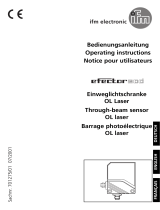
7
UK
If the setting of the sensitivity is not possible (e.g. object signal and back-
ground signal are about the same), the red LED flashes after step 3 for ap-
prox� 2 s� The unit then passes into the operating mode with the sensitivity
being unchanged�
If the setting button is not activated for 15 minutes during the programming
process, the unit passes automatically into the operating mode with the
sensitivity being unchanged�
6.3 Setting of the maximum sensitivity*
► Go into the programming mode (→ step 1).
►Align the unit so that no light is reflected�
► Press the setting button twice (→ steps 2 and 3).
* The maximum sensitivity can also be set in exactly the same way using the programming
wire (pin 2 / WH). To activate the functions the programming wire is connected for the ap-
propriate time to L+ (pin 1 / BN) for PNP units or to L- (pin 3 / BU) for NPN units.
6.4 Electronic lock
Activate the lock by connecting the programming wire for about 15 s – 20 s*�
Deactivate the lock by connecting the programming wire again for 15 s – 20 s*�
* To activate the functions the programming wire (pin 2 / WH) is connected to L+ (pin 1 / BN)
for PNP units or to L- (pin 3 / BU) for NPN units for the appropriate time.
6.5 Programming the output function*
►Press for 10 s� > The red LED starts to flash fast after 2 s�
> Then the yellow and green LEDs flash
alternately�
> After 10 s all LEDs go off, the output func-
tion has changed from light-on mode to
dark-on mode (or vice versa).
* The output function can be programmed in exactly the same way using the programming
wire (pin 2 / WH). To activate the functions the programming wire is connected for the ap-
propriate time to L+ (pin 1 / BN) for PNP units or to L- (pin 3 / BU) for NPN units.









